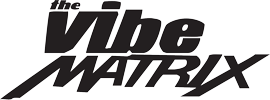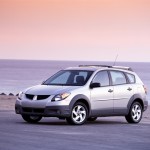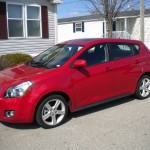PONTIAC VIBE DEBUTS WITH PURPOSEFUL, ATHLETIC EXTERIOR DESIGN
DETROIT – The Pontiac Vibe, the GM Excitement Division’s newest vehicle, brings a fresh face to the automotive market. It has a unique shape that sets it apart from everything else on the road.
A key visual element is the fast-shaped roofline. The uniquely integrated roof rack lends a sporty appearance. Overall, Vibe’s exterior is lean, trim, muscular and youthful.
“It’s unmistakably Pontiac,” said chief designer John Mack of the Vibe. “Right down to the cat-eye headlamps, recessed fog lamps and rear cornering lamps. We also gave it the traditional Pontiac wide stance, with short front overhangs and large wheels pushed out to the corners and tires to project an aggressive, ground-hugging stance that optimizes vehicle stability.”
Commanding Driving Position
Particular attention was paid to providing the Vibe driver with a high, commanding seating position behind the wheel.
“We wanted Vibe to be a little bit higher than the average vehicle in this segment,” said Mack. “It’s a lifestyle issue. Vibe addresses lifestyle needs based upon direct feedback from consumers. Uniquely combined, Vibe features the cargo space and high seating position of an SUV, performance and handling characteristics of a sports car and the security of all-wheel drive. We wanted to attack this in a way that Pontiac would do it, in its own unique, robust way. The vehicle was going to be inherently high as part of the package, which is good for the occupants.”
Mack said the design began with the specific goal in mind of creating a lifestyle vehicle that appealed to young car buyers with a sculpted, unique, rugged yet sporty appearance.
“We wanted to go after a sporty look. In doing so we created a design that has a coupe like appearance, which conveys a sporty nature,” Mack said. “We did that by laying back the upper glass line instead of shooting it straight back-the roof rack really helps define the profile of the car.”
In the end, the GM team got the coupe-like look along with some of the sportier SUV cues they were looking for. “An active lifestyle vehicle was the main goal,” Mack said. “You can tell by the trim-and other similar cues that really emphasize a more rugged aspect outside of what your typical small car would do-along with a higher, more upright position. The dual-port grille is moved up higher, giving the vehicle a little tougher stance, and making it look a little more nimble and light on its feet.”
Mack said the short overhangs also contribute to Vibe’s sporty exterior shape. “That’s a cue we wanted, a tight wheel-to-body look, with the wheels and tires as wide as possible for an aggressive wide stance.”
Functional, Convenient Rear Liftgate
The one-piece rear liftgate with separate liftglass offers a convenient, easy-to-use rear loading system which is unique to its competitive set.
Designers succeeded in incorporating the traditional Pontiac design cues on the rear end, just as on the front, including the rear cornering lamps.
“The fast roof shape contributes to good aerodynamics, as do other elements of the rear of the vehicle,” Mack said. “A clean separation in the back with the tight edge is inherently good for aerodynamics, and so is a rear end that tapers sharply.”
A Design That Defies Definition
Although Vibe ultimately defies traditional vehicle classification, it plays comfortably in nearly every automotive category, while fitting neatly into none. It offers the handling and performance of a sports car, the utility and rugged, go-anywhere range of an SUV.
Its appearance lives up to that pedigree.
“Overall, it’s a successful crossover design combining the best elements of all those segments,” Mack said. “You have a command view of the road. You’re not sitting real low in traffic – there are bigger vehicles out there and this seating position provides a nice view of the road. At the same time, when you want it to perform like a sports car, it does. The key to that aspect of its exterior design is that, not only does it perform, it looks like it performs.”
PONTIAC VIBE INTERIOR DESIGN:
THOUGHTFUL, ROOMY AND HIGHLY FLEXIBLE
DETROIT – The interior of the all-new 2003 Pontiac Vibe raises the bar for both fun and flexibility, designed with the needs of young, active buyers in mind.
“Vibe’s interior is thoughtfully done and accommodating,” said Craig Bierley, Pontiac Vibe brand manager. “It delivers an unprecedented level of convenience, a surprising amount of storage space, and versatile configurations.”
The 60/40 split rear bench seat folds flat at one touch to create a level load floor – and 57.2 cubic feet of cargo volume. The front passenger seat folds flat into a worktable. The convenient, easy-to-use liftglass/liftgate system is designed for optimal accessibility.
Innovative Rear Cargo System, and Infotainment Options
The rear floor features a unique, innovative cargo system that includes two parallel tracks running the length of the rear compartment. Adjustable sliding anchors help secure unwieldy cargo with ease.
Vibe also includes a 115-volt standard power outlet with a wall-type plug-in in the front console. Examples of the appliances it will power include laptop computers, portable radios or stereos, or shavers.
The interior is loaded with Infotainment options, including a DVD-based navigation system, a six-disc in-dash CD changer, 200-watt premium audio system and standard Radio Data System (RDS). The sporty seat fabrics are made of a flatly knitted, high-class, high-tech material and are available in two colors, slate and graphite. They have a stylish mesh knitting to the insert and a plain mesh knitting to the bolster.
Vibe is spacious and adaptive throughout, containing chrome tie-downs for securing loose cargo, a console tray, storage bins of which nine are concealed, and a welcome number of functional spaces, holders and compartments for carrying just about anything young drivers need. Vibe has easy entry and exit, supportive and fully adjustable seats, a commanding road view and intuitively placed controls.
“We wanted to create a cockpit that is distinctly Pontiac,” said Chief Designer John Mack, “the amber/orange lighting on the rounded gauges, and the chroming around the gauge cluster, for example. There was an emphasis on using high-end, upscale materials on the inside with lots of nice, tactile surfaces that are smooth to the touch, to lend an uplevel air to what is essentially an entry-level vehicle.”
Thoughtfully Laid Out, Generously Appointed
Vibe’s cockpit-like interior features a video/navigation screen, if so equipped, at the top of the center stack, bookended by stylish HVAC vents. Around that are the audio controls and the climate controls and switches to control various functions. The transmission gear shifter is located on the floor and is integrated into the instrument panel assembly to provide for efficient use of space.
The instrument panel sports gauges and warning lamps, controls for the power mirrors, an available remote opener for the rear hatch, and the security system indicator light. Next to the in-dash 115-volt AC power outlet is another power outlet-of the usual 12-volt, 100-watt variety found in most cars and trucks. Window controls, including a rear seat child lockout, are on the driver’s door panel.
There is another 12-volt power outlet inside the console box, which allows a cell phone to be charged in a concealed location. The console also contains two cupholders, a small cover storage bin, a larger covered lower bin under the console lid, a cell phone holder and a coinholder. The interior also contains sun visors, assist grips with coat hooks, cupholders, two coin pockets, ashtray, floor mats, intermittent wipers and rear window wiper, as well as an optional moonroof.
Designed from the Inside Out
The Vibe design team placed a lot of emphasis from the outset of development on creating a comfortable, flexible interior furnished with upscale materials that are smooth to the touch. The instrument panel has a matte black finish with metallic finish on the gauge cluster, center console and door trim.
“We had a lot of customer feedback on the interior, because that was a key element of the vehicle,” Bierley said. “After you look at the exterior of the car, the interior has some surprise to it, because it is so spacious. We research on such things as the materials and innovative fabrics used. We wanted something that would present a high-tech image throughout the car. The fabrics used have a more technical, and sports-athletic appearance — they do not look like the typical automotive fabric. It’s very fresh. It’s soft, but still durable and with a larger weave to it than a typical cloth pattern.”
Research also played a role in the development of the rear cargo access area. A few different solutions were considered before the Vibe design team decided that a liftgate with separate liftglass was the choice that customers found most convenient and easy to use.
“Overall, Vibe is a cleanly executed design that should appeal to young, active buyers with its fresh look and surprising interior appointments,” said Bierley. “When you see the vehicle, it has a very unique size to it. It’s so fresh in that aspect, so clean and so dynamic — and so dynamically Pontiac. We expect it to break new ground for Pontiac as a division and further increase our presence in the youth market.”
# # #







![Full Coverage of the Sno*Drift Rally 2015 [Video]](https://i0.wp.com/vibematrix.com/wp-content/uploads/2013/04/VibeMatrixLogo.jpg?resize=150%2C150)



